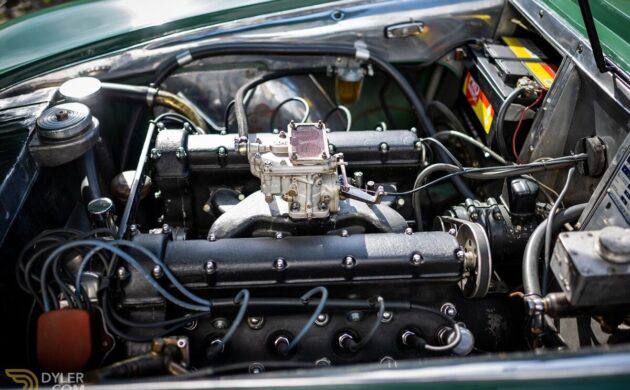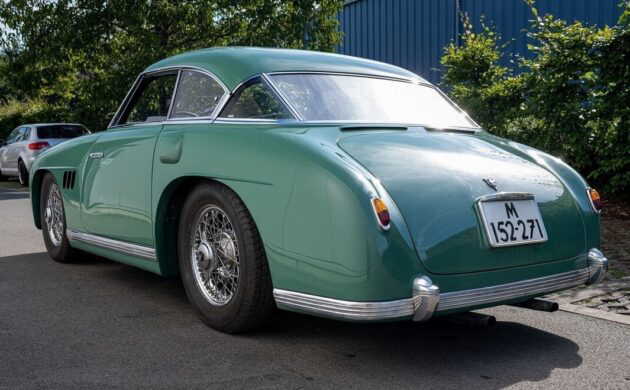This story is not about Ferrari. But the path to understanding many interesting cars is paved by his peers’ contrary reactions to Enzo Ferrari’s strong opinions and forceful personality. These actors were not shy violets, and rather than remain in the onslaught of Ferarri’s domination, they scattered to lend their talents to other enterprises. Lamborghini, complaining about how complex Ferraris were; Bizzarini fired in the “palace coup”; and Wilfredo Ricart, a Spaniard, who was annoyed by Ferrari while at Alfa – all were galvanized into competition against the autocrat of Maranello. The Pegaso above owes its existence to Ricart’s stint at Empresa Nacional de Autocamiones S.A. (ENASA), founded from the ashes of Hispano Suiza. ENASA was owned by Spain’s government, and its production was largely devoted to trucks. But Ricart designed the Z-102 to challenge Ferrari’s berth in the sports car niche. Here at Dyler is one of the earliest Pegasos, a 1951 Pegaso Z-102 Berlinetta, with an intricate history. The price is available “on request”, and the car is located in Wijnegem, Belgium. This tip comes to us from Nevadahalftrack – thanks!
Ricart’s engine was intensely ambitious: a dry sump aluminum V8 with four gear-driven camshafts, sodium valves, a Bosch magneto, and hemispherical combustion chambers. Initially, displacement was 2.5 liters but later engines grew to 2.8 and 3.2 liters. Several carburetor options were offered, from a single Weber up to four for all-out competition. Ricart even experimented with superchargers. Horsepower ran from 165 for the “base” configuration to 225 for the supercharged cars. This car was first assigned chassis 0102 and was apparently a cabriolet. In 1952 it was converted to a Berlinetta at the factory and given a 2.8-liter engine. A five-speed transaxle drives the rear wheels. At least a few examples were fitted with a ZF limited slip differential. Despite the engineering prowess applied to the car’s mechanicals, the Z-102 was not a winner on the track. But this chassis was shown quite successfully by the factory at various concours until an accident in 1954 necessitated a complete rebuild. At that point it was assigned a new chassis number – 0201 – and finally sold as a new car.
The interior is trimmed in leather, with cream-colored knobs and a painted dash. The headliner is perfect. Beautiful gauges and a wood-rimmed steering wheel complete the picture. This car has a fresh windshield (probably not a mail-order item), and all its rubber seals have been replaced. The undercarriage and engine have been stripped and painted, and the chrome was renewed.
Production numbers are a matter of debate. Anywhere from 71 to 112 examples came off the line, most of them coupes. Coachwork – mostly aluminum – was by Pegaso itself, Carrozzeria Touring, Saoutchik, or Serra, and all are different. The car was wickedly expensive to buy and its development drained the resources of ENASA, which still needed to make trucks. A second series of cars was introduced – called the Z-103 – but only three were made before sports car production shut down in 1958. Value is dependent on the coachbuilder but generally one can count on paying around $1 million for a nice example.





That’s a good looking car. Pretty much art on wheels.
So technically advanced for the time. Sodium filled exhaust valves and what looks to be hemispherical combustion chambers. You would think the 2 choke carburetor would be a limitation in this design. I also like how the wheel housings open up to merge with the fenders. Looks like aerodynamics were also a key factor in the design. I really like the interior as well with the dark green dash and the olive colored leather. Very tasteful.
I continue be schooled by BarnFinds and it’s dedicated writers. Thank you!
The seller also has a blue cabriolet / roadster listed.
Beautiful car Thai havre never heard of much less, but $1 million for a barn find? LOL More than I will spend on all cars I ever own in my lifetime I suspect
This beautiful color should be mandatory on all cars. What a calm, serene driving experience it would create…😉.
Unbelievably beautiful. I can see why these cars command such a high price. Hopefully this work of “art” stays preserved and admired. Good luck to the future of this fine automobile and the new owner.
Never saw one of these, somewhat modern looking for it’s time!
Didn´t we run this a few weeks ago? There are not many Pegasos to go round…
Actually, you have it the wrong way round on Ferrari and Ricart, Michelle. from 1920s on, Ferrari was a long-time important employee/associate of Alfa, whereas Ricart was drafted in as a “new broom” in the late 30s. He managed to get rid of both Ferrari and Jano, but contributed almost nothing himself to Alfa, other than some dud projects.
WW2 provided the Catalan with an excuse to leave Alfa, but of course, the real damage was that Ferrari went off to build his own cars….And Jano went to Lancia where he engineered the B20 and then the D50 racing cars.
Thanks for the clarification, Martin.
Great write-up!
Green is good.
Does anyone have an idea what model Pegaso this one is? I’m pretty sure it’s a Pegaso, but no mention anywhere of one looking like this. I found it in Thailand. Closest I can find is the z-103.
image0.jpeg
trying to post the image, but am having trouble.